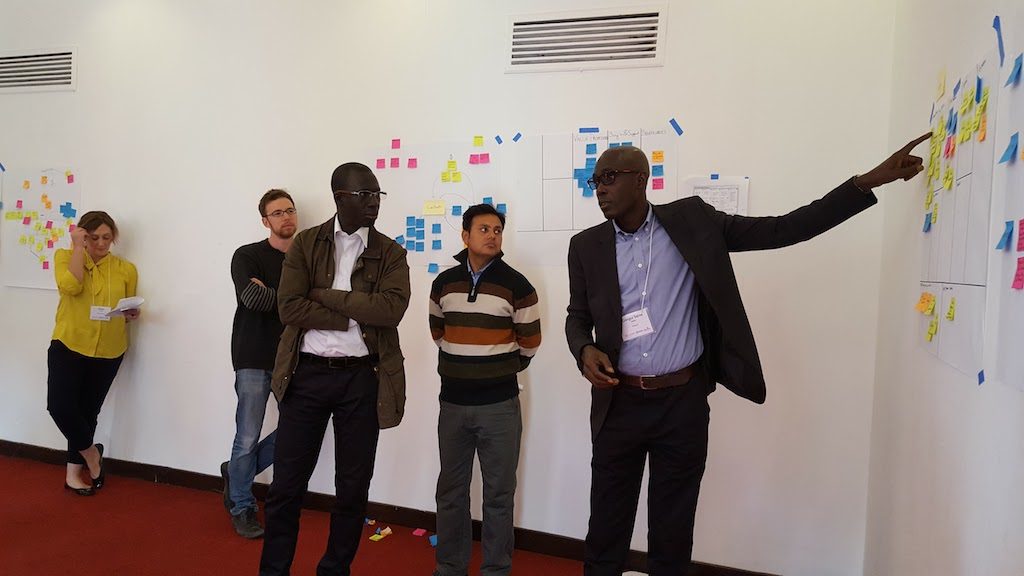
Like most startups, Sebastian Manhart managed many tasks himself when he joined the nonprofit tech venture, Simprints in 2013. While a do-it-yourself attitude is useful – and often required – when starting a new venture, it eventually becomes unsustainable. According to Manhart, thinking he could and should do it all was unrealistic. “I started to think that I was the only one who could manage sales, even though that wasn’t my area of expertise” said Manhart. “Since things were working well, I became blind to the idea that someone else could do it better.” As the company began to scale, he realized he couldn’t keep up with the pace – or the growing demands as the organization’s COO. Something had to change. “We took a chance and hired a dedicated sales person,” said Manhart. “This person not only freed up my time to tackle other responsibilities, they’re actually doing a better job than I did.”
Expanding the team also became a wise business decision for the company. “In the beginning, it made sense to outsource most of our production work,” said Manhart. “But outsourcing quickly became very costly, especially as we began to make many design changes. Also, we didn’t have enough control over quality. Hiring a full-time engineer to build and manage production of our product was one of the best decisions we made.”
Today, Simprints is on track to grow into a 30-person team by the end of the first quarter in 2018. For a team with a strong DIY mentality, how did they learn to relinquish control and hire the right people to manage critical roles? Manhart says, “We invest a great deal of time screening candidates. In some instances, we spent a year before finding the right person. But to us, that’s time well spent. We’d rather take the time to hire the right person instead of quickly filling a role with the wrong person.”
It Takes a Team to Bring an Idea to Impact
As engineers and scientists, many early stage technology innovators are focused on developing their product. But as these inventors turn their attention to pushing their technology past the research and development phase, it’s important that they begin to see that it’s essential to build a team that has the capacity to manage various aspects of the commercialization process.
Participants in our Xcelerator program often report the need for teammates with know-how in non-scientific and technical areas. “Many teams quickly realize they are a little tech centric when it comes to skills and strengths,” said Xcelerator innovation coach, Agostinho Almeida. “Some worry that skills gaps can potentially stall their team’s progress.”
These concerns are valid. Many early stage innovators run into challenges because they lack teammates with commercialization skills or business acumen. In fact, 60% of respondents who completed Xcelerator post-program surveys indicated that they do not have a well-rounded team. With over 20 years of experience supporting early stage innovators, we often see the following critical skills and knowledge missing from a team dynamic:
1) Scaling or marketing their product
2) Understanding the emerging economy context
3) Conducting customer discovery
4) Developing a business plan or strategy
5) Forming partnerships
6) Navigating complex IP and protections decisions
The art and science of building a team is something early stage innovators must master at the start of their innovation and entrepreneurship journey. This third installment of the Innovator Insights Series details the need to build a well-balanced team, the importance of hiring for the right cultural and mission fit, and the value of quality time with a team during a training program.
We spoke with the following innovator-entrepreneurs, coaches, and experts involved with the Xcelerator program about team building:
- Sebastian Manhart of Simprints
- Katie Kirsch of Sisu Global Health
- Donna Brezinski of Little Sparrows Technologies
- Agostinho Almeida and Michael Free, Xcelerator innovation experts
- Cara Barnes and Laura Sampath, both of VentureWell
Build a Well-Balanced Team
No one person has the skills – or inclination – to manage all of the tasks required to launch a venture. Each team member’s skills, experience, and personal interests contribute to the success of the initiative. That’s why it’s important to build a well-balanced team comprised of individuals with the necessary skill sets and attributes to take the project to the next level.
VentureWell program officer, Cara Barnes works with many early stage innovators during the team-building phase. Her advice: identify gaps. “When starting the team building process, think about the skills and types of people you need to round out your company,” said Barnes. “Do you need a teammate with a solid science background and a talent for sales and marketing? Do you need an engineer with the ability to manage a complicated production process?”

Global innovation expert Michael Free echoes Barnes’ insights, especially when it comes to determining potential teammates with specialized skills. “Building an idea is different from building a product,” said Free. “To translate an idea or invention into a product, early stage innovators need people with special skills around commercialization. They need people who understand how to build interest and demand in the marketplace, how to identify segments of the market that will provide early adoption, people who can vet suppliers, manufacturers, or people who know how to build manufacturing capacity.”
Team composition also depends on the pathway and business strategy. According to Almedia, “Building a team is not a one-size-fits-all approach. Think about your pathway, organizational goals, and where you are on your journey. For instance, you may want to hire an expert in business development before hiring a team of engineers. You may also not be ready for – or even need – to fill those roles.”
Xcelerator participating team, Sisu Global Health, understood the need to hire for the right mix of skills and strengths during the founding phase. Sisu’s Katie Kirsch explains: “There was a lot of intention in what we needed as we built the team. My strengths and experience are in communication, sales, and marketing. Another co-founder is a chemical engineer with leadership experience, which is a good fit for our CEO role. The third co-founder is a mechanical engineer who manages design and manufacturing.”
While Sisu was successful with building a team, knowing who to bring on board – or where to start with the process – remains a daunting task for many early stage innovators. That’s why it’s critical for innovators to take advantage of expert guidance available from training programs and workshops when starting to identify ideal team members. Free describes the role the Xcelerator program plays in helping innovators think about building a well-balanced team. “More often than not, teams have reached a stage of frustration. They either can’t recognize that they need other team members, or they aren’t sure what type of team member is appropriate. It’s important for innovators to maximize the guidance from coaches on identifying the types of people that can augment their own capacities.”
Build a Well-Aligned Team
Building a team is an intricate, complicated process. It requires a strategic understanding of where to go and what people are needed to get there. While it’s critical to identify and hire for particular skills gaps, high-functioning ventures also have team members who are aligned with the organizational mission and culture.
At Simprints, the focus on mission guides how they hire. “Our key value is relentless commitment to impact,” said Manhart. “We want to surround ourselves with people who are open, honest, and think about the team first. It won’t work if we hire someone only interested in pushing their own agenda.”
The clear organizational mission informs the conversations Simprints has with prospective team members. “In conventional startups, going the extra mile can be driven by financial incentives. In our case, going the extra mile comes from commitment and passion,” said Manhart. “We’ve developed screening questions for this value.”

For Sisu, choosing teammates aligned with the company mission allows the team to keep communication channels open and honest at all times. According to Kirsch, this keeps the team focused on the big picture. “We all share the same goal. We don’t just want to make a product. We want to build a venture with impact. That’s why we value the positive friction of questioning our assumptions and decisions. We’re constantly moving in different directions, working on many projects at once. We regularly ask one another if we’re going about something in the right way, and if it ultimately serves our mission. That approach really keeps our mission front and center.”
For Donna Brezinski of Little Sparrows Technologies, finding people who are a “good fit” is a function of de-risking the commercialization process – an important activity for financially vulnerable startups. “A huge factor to de-risking a business is to build the right team. When I’m expanding the company, I carefully screen potential teammates to make sure they’re committed to the company mission. I’ve learned from experience that having a cohesive team working together toward a common goal reduces the distracting hiring-firing churn that occurs when companies don’t bring on the right people.” Brezinski has found it helpful to include her team in the vetting process. “We all have to work closely together. That’s why I have candidates meet every member of the team during the interview process to make sure the potential teammate is the right fit.”
During the interview process, innovators should consider potential teammates for the long haul. That’s why it’s important to pay close attention to first impressions. As Almeida pointed out, “Pay attention to the chemistry among people. If a first impression isn’t good, that’s a sign that the relationship won’t work out in the long run. There will likely be no human resource manager when you run into trouble. You need to find people who share your vision and who you want to work with.” Free agrees that pulling a team together relies on instinct. As he explained, “Sensing if people have the right stuff is a teachable skill, but much of it is instinctual. Listen to your gut when screening people. With practice, you’ll be able to intuitively recognize their drives and motivations.”
While hiring for skills and strengths is necessary to make a company work, selecting teammates who champion the organizational mission – and who click with other team members – can make a company soar. “I’ve seen teams derail despite being highly-skilled innovators with an impressive technology and promising business plans,” said VentureWell Vice President of Programs, Laura Sampath. “Why? Because the team didn’t gel. People underestimate the importance of team building. It’s a secret ingredient that can make or break an early stage venture that values a diversity in skills, talents, and approaches.”
Strengthen Team Alignment During Programs
Once a team is assembled, it’s important to continue to form solid bonds and conduct high-level thinking and planning about the company. Programs like Xcelerator provide opportunities to focus on strategy development and foster important discussions between teammates.
“I see just about every Xcelerator participant team taking advantage of the dedicated, structured strategic planning time – free from outside distraction – to grapple with the most critical decisions for their project success,” said Sampath. “The program also provides teams access to expert coaches, mentors, and trainers – a valuable resource they don’t have access to everyday.”

For many participants in the Xcelerator program, team members are spread across the country – or the world. The program can be the first time they work together in one place as a team. “Many participants only have brief discussions about strategy outside of a program because they’re managing the many moving parts of launching a venture, or they simply aren’t in the same room enough” said Almeida. “They only have time to talk about what they should be doing in the near term. But during a program they have the space to think past individual roles and dreams to hash out real business decisions.”
To make the most of dedicated program time, Free recommends coming prepared to address big ideas or challenges – as a team. “Teams that effectively engage with the Xcelerator experience, both in preparation, during the program, and with follow-up opportunities, are much more likely to be ready to map out a business strategy, choose the right partners, take advantage of real-time mentor feedback, and develop tactical plans to move their plans forward with confidence,” said Free.
For newly formed teams, a program is also an opportunity to test team alignment. “Programs cover a lot of ground in a few days. They’re designed to push participants to see if a team is on the right track or if they need to go back to the drawing board,” said Almeida. “If your team isn’t reaching alignment during the program, that’s evidence that there are potential cracks in the team’s foundation. Listen to that and address it during or shortly after the program.”
Like everything else in innovation, forming a team is an evolutionary process. To help streamline the complicated process, it’s crucial for innovators to create a team-building strategy during the initial venture development phase. That includes conducting a skills gap assessment and designing a screening process to ensure potential candidates are a good fit – both with the organization’s mission and culture. Coaches and mentors can help innovators identify skills gaps on a team or think about the types of individuals to fill a particular role. Programs can provide innovators with an opportunity to solidify team alignment, develop strategic goals as a team, and tap into expert advice as they work through ideas and plans.
The remaining articles in our Innovator Insights Series will focus on the hard-learned lessons of seasoned entrepreneurs that help illuminate the path for tomorrow’s innovators, with the next installment taking a close look at the importance of understanding global customers.
Other Installments in the Innovator Insights Series
Preparing for the Innovation and Entrepreneurship Journey
Mastering Strategy Development